Dr. Mike Barratt is one of an elite group in the United States. Only about 60 men and women in the U.S. have similar skill sets, and none of them, he says, are out of jobs.
“That’s such a misconception!” Barratt announced on a recent trip to Fall City to visit family. “The idea that human space flight is over is preposterous.”
Barratt is an astronaut, one of 60 currently on staff at NASA. He is the brother-in-law of Fall City martial arts instructor Johann Sasynuik; his wife Michelle is Johann’s sister. He grew up in Camas, Wash., now lives in Houston, but is a regular Valley visitor.
Barratt is confident that the United States will soon be sending its own manned vehicles into space again, and soon.
He has plenty of reasons to think so.
“There’s a lot out there that we don’t know, so we want to find out. There’s a lot out there that, the knowledge of which, can affect who we are
and how we live right now.” Studies of climate, geology, spread of disease, and agriculture are just the beginning. Biology research can progress further, faster, with the opportunity to study organisms free of gravity’s effects.
Also, “there are places to go. There’s the moon, which may have a lot of resources on it. The solar system is a much more interesting place than I grew up with … the possibility of life in the solar system is much higher than when I was a little punk.”
Without pausing for a breath, he rattles off why it’s possible: “You’ve got water on Mars, you’ve got water on the moon, you’ve got water on Mercury believe it or not, you know, the planet closest to the sun, in the shaded area,” Studies of space have also revealed water on moons in Jupiter’s and Saturn’s orbits, and, most recently, he excitedly reports “almost smoking-gun evidence” that Mars has flowing water.
Barratt has visited space twice, once in 2009 for a six-month stint on the International Space Station, and earlier this year, on the final flight of the Discovery. Although he feels that NASA was right to retire the 25-year-old shuttle program, he said that last Discovery flight was difficult, once the crew was on the ground, walking around the shuttle for the last time.
“You’re under this incredibly beautiful spaceship that just an hour before was going Mach 25, screaming out of orbit. And you’re walking around with the people who have been taking care of that orbiter since ‘84…and you are handing it back to them for the last time.”
Our astronauts, though, are definitely not losing their jobs, Barratt says. His own position at NASA these days is specifically to get the astronaut corps space-ready for the next generation of manned spaceships.
“The agency itself is building something that can go beyond a low-earth orbit,” Barratt said, and four major aerospace firms are developing prototype four-man capsules for transporting U.S. astronauts to and from the International Space Station.
Barratt hopes to return to the space station some day, for another long-term stay, but he has no aspirations for what many people expect will be the space program’s next target, Mars. It’s not such a far-out possibility today, Barratt says, it’s more a question of “How far are we from making the decision to go?”
Like every milestone of the space program, the decision is the small step that has to come before the giant leap. “We did it then, because we decided to do it,” Barratt said.



